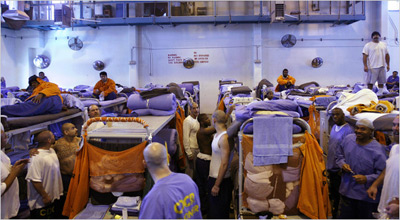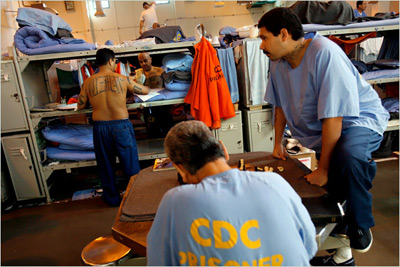The California budget crisis has forced the state to address a problem that expert panels and judges have wrangled over for decades: how to reduce prison overcrowding.

The prison in Lancaster, Calif., has 4,600 inmates, twice the intended number. Some 150 prisoners are held in the gymnasium. (Ann Johansson for The New York Times)
The state has begun in recent weeks the most significant changes since the 1970s to reduce overcrowding - and chip away at an astonishing 70 percent recidivism rate, the highest in the country - as the prison population becomes a major drag on the state's crippled finances.
Many in the state still advocate a tough approach, with long sentences served in full, and some early problems with released inmates have given critics reason to complain. But fiscal reality, coupled with a court-ordered reduction in the prison population, is pouring cold water on old solutions like building more prisons.
About 11 percent of the state budget, or roughly $8 billion, goes to the penal system, putting it ahead of expenditures like higher education, an imbalance Gov. Arnold Schwarzenegger has vowed to fix.
The strains on the system are evident inside the state prison here, about 50 miles north of Los Angeles, where 4,600 inmates fill buildings intended for half as many. A stuffy, cacophonous gymnasium houses nearly 150 people in triple-bunked beds stretching wall to wall.
The new effort this year is intended to remove from prisons criminals who are considered less threatening and divide them into two categories: those who pose little or no risk outside the prison walls, and those who need regular supervision.
The goal is to reduce the number of inmates in the state's 33 prisons next year by 6,500 - more than the entire state prison population in 2009 of Nebraska, New Mexico, Utah or West Virginia. In all, there are 167,000 prisoners in California.
"People in the criminal justice world are looking at California with great interest," said Jeremy Travis, president of John Jay College of Criminal Justice in New York. "Some very important reforms are under way."
The effort, narrowly approved by the Democratic-controlled State Legislature and signed into law by Mr. Schwarzenegger, a Republican, will be achieved through a range of steps long recommended by independent analysts and commissions.
To slow the return of former inmates to prison for technical violations of their parole, hundreds of low-level offenders will be released without close supervision from parole officers. Those officers will focus instead on tracking serious, violent offenders.
Some prisoners may also be released early for completing drug and education programs or have their sentences reduced under new formulas for calculating time served in county jails before and after sentencing.
The effort represents a "seismic shift," said Joan Petersilia, a criminologist at Stanford Law School and a longtime scholar of the state's prisons.

Inmates in their quarters in the gymnasium. To slow the revolving door of parolees returning to prison for technical violations of their parole, a major contributor to the state's recidivism rate, hundreds of low-level offenders will be released without close supervision from parole officers. Those officers, instead, will focus on tracking serious, violent offenders. (Photo: Ann Johansson for The New York Times)
Public safety concerns have other states rethinking their decisions to save prisons costs by releasing inmates early and expanding parole.
The same red flags are being raised here, but the overcrowding problem dwarfs that of any other state and the budget deficit - $20 billion and climbing - has left lawmakers with virtually no choice but to move ahead.
The Schwarzenegger administration has floated a number of other ideas to reduce costs, including building prisons in Mexico for illegal immigrant offenders, turning over prisons to private contractors and, last week, having the University of California handle inmate health care.
The release of prisoners in California has stirred a backlash. Several hundred inmates at county jails were released in the last couple of months because of confusion over time credits in the new law.
Attorney General Jerry Brown, a Democrat who is running for governor, issued a directive clarifying the law, but not before one inmate in Sacramento was arrested shortly after his release and charged with attempting to rape a woman. The man had been released on probation after serving time on an assault charge.
That case prompted several lawmakers to call for abandoning early releases. And crime victim and law enforcement groups have been sounding alarms about what they consider the dangers of not more aggressively tracking the low-level offenders.
"We are concerned about victims these felons will leave in their wake before being rearrested for committing new crimes," said Paul M. Weber, the president of the Los Angeles police union.
Proponents, including Mr. Schwarzenegger's corrections secretary, Matthew Cate, have stood by the law, calling it overdue and necessary. The state spends, on average, $47,000 per year to house a prisoner. Early estimates suggest the new changes could save $100 million this year.
"This was an opportunity to do something impactful without imperiling public safety," Mr. Cate said, adding that allowing parole officers to focus on more serious offenders will improve public safety.
Even with the new law, the system falls short of providing the kind of rehabilitation, drug treatment and education and job programs that academics and prisoner advocates have called for to help ensure prisoners and parolees do not commit new crimes.
The governor and the Legislature received a report on March 15 from a state oversight board warning that cuts to inmate rehabilitation programs would jeopardize the effort to reduce recidivism.
California is the only state that places all prisoners on parole at release, no matter the offense, Professor Petersilia said, and usually for one to three years. If a parolee is arrested or fails a drug test or misses an appointment with a parole officer, the offender lands back in prison.
Now, low-level offenders will not need to meet regularly with a parole officer and must be convicted of a new crime to be sent back.
Eric Susie, 24, recently had his parole terms readjusted under the new law. Mr. Susie had served 13 months in prison for possessing an M-80 firecracker wrapped with razors near a school (he argued, unsuccessfully, that it belonged to a friend).
Now, more than a year out of prison, he no longer reports to a parole officer or submits to monthly drug tests and can travel more freely, including out of state to visit family in Las Vegas.
"I feel like I am finally free," Mr. Susie said. "I feel like I don't have that monkey on my back, like being a prisoner. I feel like I am a human being and can get my life together."
Even the guards' union, which so heavily promoted and supported the tough sentencing of the past that fueled the prison building and expansion boom, now says it supports the idea of alternatives to prison and did not publicly object to the new law.
The overcrowding, union officials now say, poses a physical threat to its members, and the union has sided with plaintiffs battling in federal court to force even greater reductions of 40,000 inmates over the next two years.
But even with the progress in recent months, State Senator Mark Leno, a Democrat from San Francisco who helped push through changes in the prison system, suggested that further reductions would be a hard sell. Mr. Leno called the changes under way "a noble effort" and the best that could be achieved in the current political climate.
Many lawmakers, he said, still want to lengthen sentences and spend more on incarceration, both politically popular notions.
"We can't control ourselves," Mr. Leno said. "Or some of my colleagues can't control themselves."











